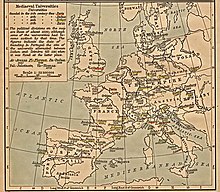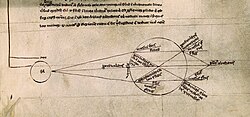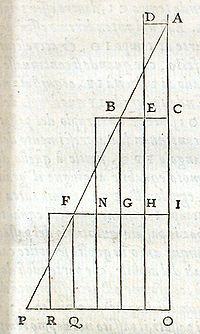High Middle Ages (AD 1000–1300)
Beginning around the year 1050, European scholars built upon their existing knowledge by seeking out ancient learning in
Greek and
Arabic texts which they translated into Latin. They encountered a wide range of classical Greek texts, some of which had earlier been translated into Arabic, accompanied by commentaries and independent works by Islamic thinkers.
Gerard of Cremona is a good example: an Italian who traveled to Spain to copy a single text, he stayed on to translate some seventy works. His biography describes how he came to Toledo: "He was trained from childhood at centers of philosophical study and had come to a knowledge of all that was known to the Latins; but for love of the
Almagest, which he could not find at all among the Latins, he went to Toledo; there, seeing the abundance of books in Arabic on every subject and regretting the poverty of the Latins in these things, he learned the Arabic language, in order to be able to translate."

Map of
medieval universities. They started a new infrastructure which was needed for scientific communities.
This period also saw the birth of
medieval universities, which benefited materially from the translated texts and provided a new infrastructure for scientific communities. Some of these new universities were registered as an institution of international excellence by the
Holy Roman Empire, receiving the title of
Studium Generale. Most of the early
Studia Generali were found in
Italy,
France,
England, and
Spain, and these were considered the most prestigious places of learning in
Europe. This list quickly grew as new universities were founded throughout Europe. As early as the 13th century, scholars from a
Studium Generale were encouraged to give lecture courses at other institutes across Europe and to share documents, and this led to the current academic culture seen in modern European universities.
The rediscovery of the works of
Aristotle allowed the full development of the new
Christian philosophy and the method of
scholasticism. By 1200 there were reasonably accurate Latin translations of the main works of Aristotle,
Euclid,
Ptolemy,
Archimedes, and
Galen—that is, of all the intellectually crucial ancient authors except
Plato. Also, many of the medieval Arabic and Jewish key texts, such as the main works of
Avicenna,
Averroes and
Maimonides now became available in Latin. During the 13th century,
scholastics expanded the
natural philosophy of these texts by commentaries (associated with teaching in the universities) and independent treatises. Notable among these were the works of
Robert Grosseteste,
Roger Bacon,
John of Sacrobosco,
Albertus Magnus, and
Duns Scotus.
Scholastics believed in
empiricism and supporting Roman Catholic doctrines through secular study, reason, and logic. The most famous was
Thomas Aquinas (later declared a "
Doctor of the Church"), who led the move away from the
Platonic and
Augustinian and towards
Aristotelianism (although
natural philosophy was not his main concern). Meanwhile, precursors of the modern
scientific method can be seen already in Grosseteste's emphasis on
mathematics as a way to understand nature and in the empirical approach admired by Roger Bacon.

Optical diagram showing light being refracted by a spherical glass container full of water (from Roger Bacon,
De multiplicatione specierum)
Grosseteste was the founder of the famous
Oxford franciscan school. He built his work on
Aristotle's vision of the dual path of scientific reasoning. Concluding from particular observations into a universal law, and then back again: from universal laws to prediction of particulars. Grosseteste called this "resolution and composition". Further, Grosseteste said that both paths should be verified through experimentation in order to verify the principals. These ideas established a tradition that carried forward to
Padua and
Galileo Galilei in the 17th century.
Under the tuition of Grosseteste and inspired by the writings of Arab
alchemists who had preserved and built upon
Aristotle's portrait of
induction, Bacon described a repeating cycle of
observation,
hypothesis,
experimentation, and the need for independent
verification. He recorded the manner in which he conducted his experiments in precise detail so that others could reproduce and independently test his results - a cornerstone of the
scientific method, and a continuation of the work of researchers like
Al Battani.
Bacon and Grosseteste conducted investigations into
optics, although much of it was similar to what was being done at the time by Arab scholars. Bacon did make a major contribution to the development of science in medieval Europe by writing to the
Pope to encourage the study of natural science in university courses and compiling several volumes recording the state of scientific knowledge in many fields at the time. He described the possible construction of a
telescope, but there is no strong evidence of his having made one.
Late Middle Ages (AD 1300–1500)
The first half of the 14th century saw the scientific work of great thinkers. The
logic studies by
William of Occam led him to postulate a specific formulation of the principle of
parsimony, known today as
Occam's Razor. This principle is one of the main heuristics used by modern science to select between two or more
underdetermined theories.
As Western scholars became more aware (and more accepting) of controversial scientific treatises of the Byzantine and Islamic Empires these readings sparked new insights and speculation. The works of the early Byzantine scholar
John Philoponus inspired Western scholars such as
Jean Buridan to question the received wisdom of
Aristotle's mechanics. Buridan developed the theory of
impetus which was a step towards the modern concept of
inertia. Buridan anticipated
Isaac Newton when he wrote:

Galileo's demonstration of the law of the space traversed in case of uniformly varied motion. It's the same demonstration that
Oresme had made centuries earlier.
. . . after leaving the arm of the thrower, the projectile would be moved by an impetus given to it by the thrower and would continue to be moved as long as the impetus remained stronger than the resistance, and would be of infinite duration were it not diminished and corrupted by a contrary force resisting it or by something inclining it to a contrary motion.
Thomas Bradwardine and his partners, the
Oxford Calculators of
Merton College, Oxford, distinguished
kinematics from
dynamics, emphasizing kinematics, and investigating instantaneous velocity. They formulated the
mean speed theorem:
a body moving with constant velocity travels distance and time equal to an accelerated body whose velocity is half the final speed of the accelerated body. They also demonstrated this theorem—essence of "The Law of Falling Bodies" -- long before
Galileo is credited with this.
In his turn,
Nicole Oresme showed that the reasons proposed by the physics of Aristotle against the movement of the earth were not valid and adduced the argument of simplicity for the theory that the earth moves, and
not the heavens. Despite this argument in favor of the Earth's motion Oresme, fell back on the commonly held opinion that "everyone maintains, and I think myself, that the heavens do move and not the earth."
The historian of science
Ronald Numbers notes that the modern scientific assumption of
methodological naturalism can be also traced back to the work of these medieval thinkers:
- By the late Middle Ages the search for natural causes had come to typify the work of Christian natural philosophers. Although characteristically leaving the door open for the possibility of direct divine intervention, they frequently expressed contempt for soft-minded contemporaries who invoked miracles rather than searching for natural explanations. The University of Paris cleric Jean Buridan (a. 1295-ca. 1358), described as "perhaps the most brilliant arts master of the Middle Ages," contrasted the philosopher’s search for "appropriate natural causes" with the common folk’s erroneous habit of attributing unusual astronomical phenomena to the supernatural. In the fourteenth century the natural philosopher Nicole Oresme (ca. 1320–82), who went on to become a Roman Catholic bishop, admonished that, in discussing various marvels of nature, "there is no reason to take recourse to the heavens, the last refuge of the weak, or demons, or to our glorious God as if He would produce these effects directly, more so than those effects whose causes we believe are well known to us."
However, a series of events that would be known as the
Crisis of the Late Middle Ages was under its way. When came the
Black Death of 1348, it sealed a sudden end to the previous period of massive scientific change. The plague killed a third of the people in Europe, especially in the crowded conditions of the towns, where the heart of innovations lay. Recurrences of the plague and other disasters caused a continuing decline of population for a century.
Renaissance of the 15th century
The 15th century saw the beginning of the cultural movement of the
Renaissance. The rediscovery of Greek scientific texts, both ancient and medieval, was accelerated as the
Byzantine Empire fell to the
Ottoman Turks and many
Byzantine scholars sought refuge in the West, particularly
Italy. Also, the invention of
printing was to have great effect on European society: the facilitated dissemination of the printed word democratized learning and allowed a faster propagation of new ideas.
When the Renaissance moved to Northern Europe that science would be revived, by figures as
Copernicus,
Francis Bacon, and
Descartes (though Descartes is often described as an early
Enlightenment thinker, rather than a late Renaissance one).
Byzantine and Islamic influences
Byzantine science played an important role in the transmission of
classical knowledge to the
Islamic world and to
Renaissance Italy, and also in the transmission of medieval
Arabic knowledge to Renaissance Italy. Its rich historiographical tradition preserved ancient knowledge upon which splendid
art,
architecture,
literature and technological achievements were built.
Mathematics
Byzantine scientists preserved and continued the legacy of the great
Ancient Greek mathematicians and put mathematics in practice. In early
Byzantium (5th to 7th century) the architects and mathematicians
Isidore of Miletus and
Anthemius of Tralles used complex mathematical formulas to construct the great “
Hagia Sophia” temple, a magnificent technological breakthrough for its time and for centuries afterwards due to its striking geometry, bold design and height. In late Byzantium (9th to 12th century) mathematicians like
Michael Psellos considered mathematics as a way to interpret the world.




































